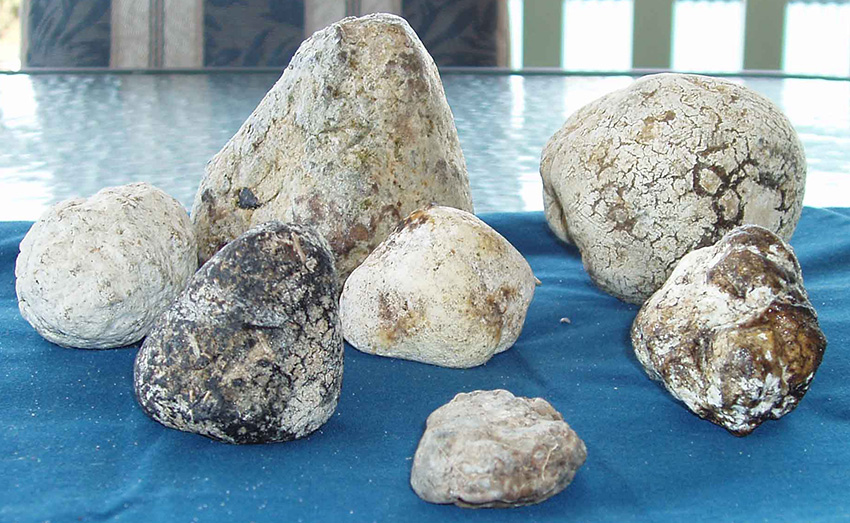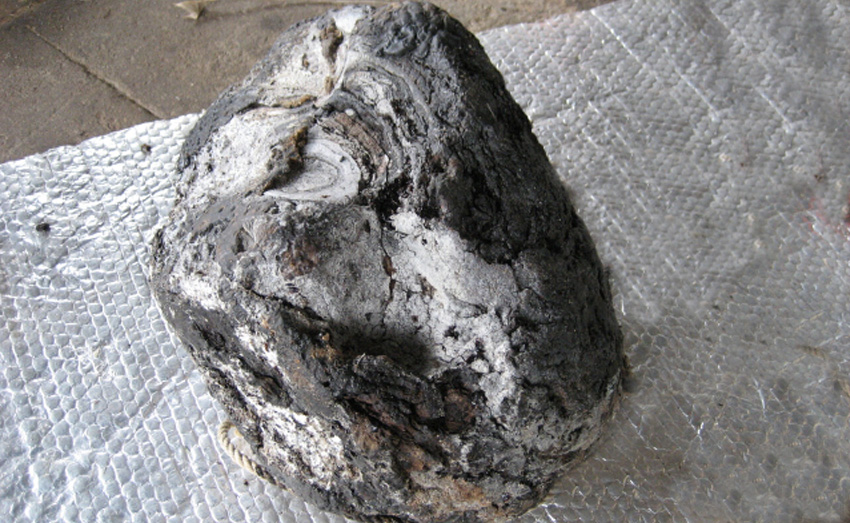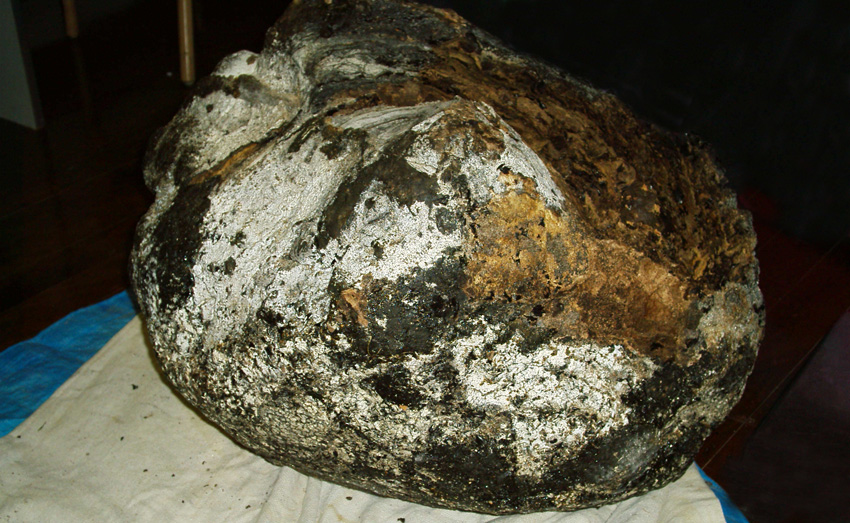Ambergris information
Description
The ambergris is a pathological secretion of the widespread spermwhale, Physeter macrocephalus, due seemingly to the irritation of the stomach by the beaks of octopus and certain shellfish. The animal releases amber spontaneously. However, the proportion of animals secreting amber is small (between 3 and 4%).
Freshly expelled, amber has generally a dark blackish colour, a flabby consistency and a nauseating odour. Under the simultaneous action of the sea water and the atmosphere, ambergris takes a more and more clear tinge, silver-grey to golden yellow, and at last it becomes almost white. Its smell becomes refined, sweet, very pleasant and characteristic.
The bacterium “Spirillum recti physeteris” is thought responsible for the production of the pleasant odour principle of ambergris in the gut of the sperm whale. Spermwhales are notorious sufferers from colic and when they are basking on the surface quietly it is easy to hear great rumblings in their guts punctuated by monumental belches that can be heard at great distances over the sea.
History
Ambergris was known and considered as an imperial trade article in Africa since 1000 B.C. During the same period, the Chinese knew ambergris as “Lung Sien Hiang” or “dragon’s spittle fragrance”, which was supposed to come from the spittle of sea dragons sleeping on sea rocks and drooling into the ocean.
Ambergris was well known to the ancient Egyptians who used it as incense.
In the 10th century Ibn Haukal, an Arab trader, classed it in value with gold and black slaves and referred to its reputed aphrodisiac properties.
Ambergris that was badly kept was used, in Near East and Roma, in perfume making; it also went into recipes of the pharmacopoeia. In Asia, ambergris was employed as a spice in cooking. The Turks considered it the most pleasing offering to Allah to bring with them on their life pilgrimage to Mecca.
Note: do not confuse with the yellow amber, the fossil resin of a tree living 40 millions years ago, and whose trade was flourishing in Antiquity.
The name comes from the Arabic “Anbar”.
Historical records of ambergris lump discoveries:
– The “bark Splendid of Dunedin”, New Zealand, was found in 1883; it weighed 983 lb. and was worth $250,000.
– On December 24, 1908 a “boulder” of ambergris weighing 1003 lb., the largest ever found, was brought in by the whalers of Larvik in Norway. It sold for £23,000 and saved the company from bankruptcy.
– Another lump which weighed 926 lb. was found in the Antarctic by the whaling ship Southern Harvester in 1953.
– The Spanish whaling station Getares on the Falkland Islands found a whale with a 304 lb. lump of ambergris in 1927 that it sold to the Norwegians, owners of the only other whaling company in the Falklands, for Kr400,000, considered an outrageous price (high or low is not mentioned).
Ambergris collection
The Spermwhale that produces Ambergris is so called for the large amount of fine and valuable oil that is found behind its head (oil of spermaceti).
This animal was an enormous source of raw materials before the advent of chemical industry at the beginning of the century (oil, meat, fat, bones etc…) but was not hunted for the Ambergris because that substance is naturally regurgitated by the animal and floats on the oceanic streems to reach the beaches.
So, floated amber is collected :
– Always in the South hemisphere
– Bermudas, Bahamas, Somailia, Ethipia, Mozambia
– New Caledonia, Australia, New Zealand
– Sri Lanka, Madagascar, The Maldives, Philippines
– Pacific Islands
Up to 500 kg lumps were discovered in the past (see History). However, commonly lumps found average 100 kg. A recorded discovery in New Caledonia end of 2003 was a 130 kg one.
We remember also that there are no international restrictions on the import and export of Ambergris. Ambregris is not subject to CITES, it does not require any certificate to export.
Amber gris needs at least 2 or 3 years of maturation to be used in the perfume industry.
Olfactive description
Amber, musky, warm, animal, sea, with a tobacco note. The main constituent of ambergris is the alcohol ambrein, which upon exposure to light and air, oxidizes to form, among other odoriferous products, very valuable amber and floral lactones, aldehydes, and ketones. Today, a percentage of ambergris has been replaced by synthetic products in the perfume industry.
Use in perfume
Used in trace into perfumes, it rather serves, like the musk or the civet, for fixing and for exalting other too delicate and too evanescent fragrances. It is too expensive to be used in soaps. The perfumer Poucher defines several grades and types of ambergris and notes that it imparts a velvetiness to fine and expensive perfumes. It is a good fixative for floral scents and one drop on a piece of paper can last for months in the open.



For any information, please contact: ambergrisfr@gmail.com
Bernard PERRIN Courtage
Z.I. des Bois de Grasse
B.P. 91006 – Arthes
06131 GRASSE Cedex
FRANCE
phone: 00 33 611745109
